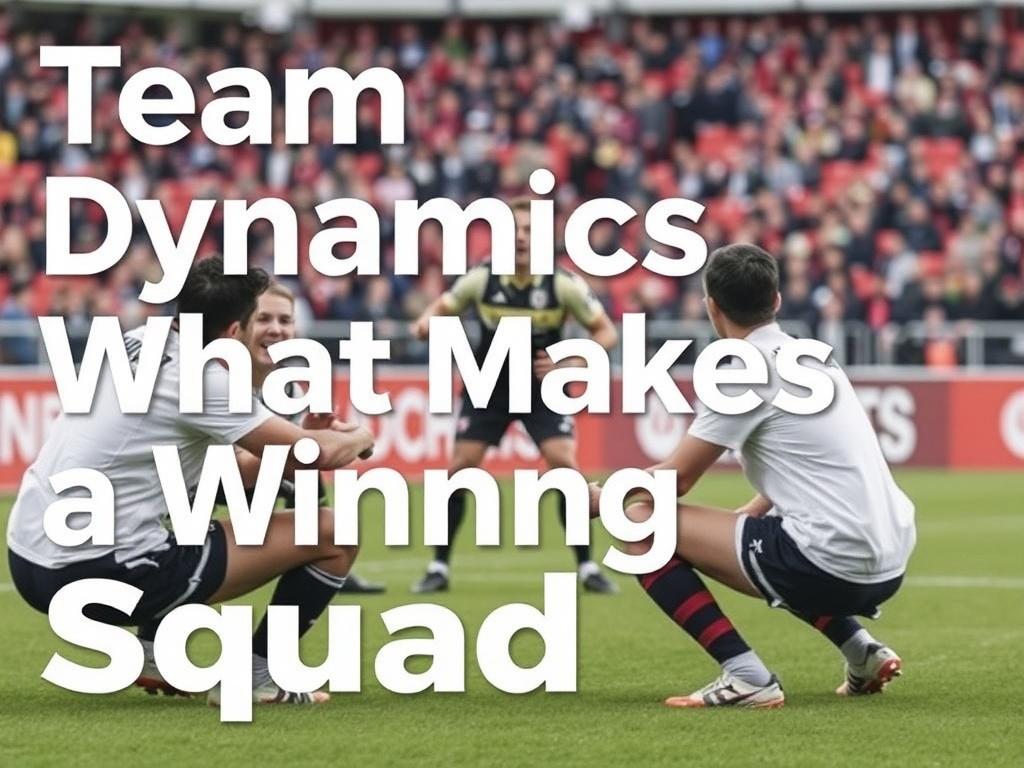When you watch a team play a sport, collaborate on a project, or work towards any common goal, there’s something truly fascinating about how they function as a unit. It’s not just the skills of individuals that matter; it’s the intricate web of interactions, communication, and mutual trust that forms the backbone of a winning squad. Team dynamics refer to these complex relationships and behaviors that take place within a group. Understanding team dynamics is essential because they can make or break a team’s success. Whether you’re a coach, manager, or a member of a group, knowing what makes a winning squad is crucial to achieving outstanding results. Let’s dive deep into the components of team dynamics and what every successful team embraces.
Understanding Team Dynamics: The Foundation of Success

Team dynamics encompass how team members interact, communicate, and collaborate towards their shared objectives. They include the unwritten rules, roles, and relationships that determine how well the group functions. When team dynamics are positive, the environment fosters productivity, creativity, and motivation. On the contrary, poor team dynamics lead to confusion, miscommunication, and conflict.
One of the key aspects that influence team dynamics is the balance between individual talents and collective effort. Even if a team has star players, without cohesion, those strengths can fail to translate into victories or results. This is why many experts say the sum of a team is greater than its parts. But how do you build that sum effectively? It takes deliberate efforts involving trust, communication, shared goals, and leadership.
Key Components of Team Dynamics
To understand what makes a winning squad, you first need to understand the key elements that make up effective team dynamics. Below is a breakdown:
| Component | Description | Impact on Team |
|---|---|---|
| Communication | Clear, open, and honest exchange of information and feedback. | Prevents misunderstandings, builds trust, and ensures everyone is on the same page. |
| Trust | Belief in the reliability and integrity of team members. | Encourages risk-taking, collaboration, and reduces conflict. |
| Roles and Responsibilities | Clearly defined tasks and expectations for each member. | Ensures accountability and efficient workflow. |
| Conflict Resolution | Methods used to manage disagreements and differences. | Maintains harmony and focuses energy on goals instead of disputes. |
| Leadership | Guidance and direction provided by leaders and influencers. | Sets the tone, motivates, and helps navigate challenges. |
Each one of these areas plays a vital role in forming the foundation of a coherent and successful team. Over time, teams that consistently focus on refining these components tend to outperform others in both professional and athletic settings.
The Role of Communication in a Winning Squad

One cannot talk about team dynamics without emphasizing the central role communication plays. This is more than just talking or giving instructions—it’s about active listening, empathy, and the free flow of ideas that fosters collaboration.
Effective communication starts with clarity. When team goals, expectations, and feedback are clearly communicated, it eliminates ambiguity which can otherwise cause friction. Moreover, communication within a winning squad is two-way. Team members feel safe to express concerns, suggest solutions, and admit mistakes without fear of judgment or reprisal.
Good communication also means adapting styles to fit the team’s needs. Some groups thrive with casual, ongoing conversations, while others perform better with structured meetings and written updates. Recognizing these preferences is part of what makes team dynamics work smoothly.
Communication Tips for Building a Winning Squad
- Encourage open forums where everyone can share ideas without interruption.
- Use tools such as instant messaging, video calls, and emails effectively to stay connected.
- Practice active listening—repeat or summarize cues to ensure understanding.
- Address misunderstandings immediately to prevent escalation.
- Create a culture that values honest and respectful communication.
When communication thrives, team members don’t just work alongside each other—they understand and support one another in reaching shared objectives.
Trust: The Glue That Holds a Team Together
Trust is often described as the glue that holds a winning squad together. It’s the confidence that teammates have in each other’s abilities, character, and intentions. Building trust takes time and consistent effort but, once established, it transforms a team environment.
Without trust, members hesitate to delegate tasks or share important information. They may withhold their best ideas out of fear or doubt, which leads to stagnant performance. Conversely, teams with high trust levels encourage each other to take risks, innovate, and hold themselves accountable without defensiveness.
Trust also plays a key role in emotional safety. A team member who believes their voice will be respected will be more engaged and motivated. This mutual respect creates resilience, enabling teams to navigate setbacks and challenges with unity rather than blame.
Building Trust Within Teams
Here are practical ways to cultivate trust in your team:
- Be transparent about goals, progress, and setbacks.
- Keep promises and meet deadlines consistently.
- Celebrate achievements, both individual and team-wide.
- Show vulnerability by admitting mistakes and learning from them.
- Encourage collaboration rather than competition among team members.
These behaviors promote an atmosphere where individuals feel valued and supported, which strengthens overall team cohesion.
Clearly Defined Roles and Responsibilities
Another critical piece in the puzzle of team dynamics is clarity in roles and responsibilities. Often, confusion arises when team members aren’t sure about their scope of work or how they contribute to the bigger picture. This can cause duplication of efforts, gaps in workflows, or even friction.
In a winning squad, every member’s role is well defined and understood by everyone else. This clarity prevents overlap while also ensuring accountability and specialists’ talents are fully utilized.
One effective method teams use is to create a responsibility assignment matrix sometimes called a RACI chart:
| Role | Responsible | Accountable | Consulted | Informed |
|---|---|---|---|---|
| Team Lead | X | X | X | |
| Member A | X | X | ||
| Member B | X | X |
Such methods help eliminate ambiguity and track who does what, making it easier to hold members accountable and manage dependencies efficiently.
Tips to Define Roles Effectively
- Discuss each role in a team meeting to ensure understanding and buy-in.
- Align roles with individuals’ strengths and developmental goals.
- Review and adjust roles periodically as projects evolve.
- Ensure backup plans in case someone is unavailable or a task needs reassignment.
When roles are clear, teams gain direction and synergy, which propels them toward their goals faster.
Managing Conflict Like a Pro
Conflict in teams is inevitable. When diverse personalities and ideas come together, disagreements are bound to happen. However, what differentiates a winning squad from others is how conflict is managed.
Rather than avoiding or suppressing conflict, a healthy team views it as an opportunity for growth. Constructive conflict encourages innovation and helps identify problems that may otherwise fester unnoticed.
Key to managing conflict is addressing issues early before they become full-blown disputes. It’s also important to separate personal from professional conflicts and focus on solving problems rather than assigning blame.
Effective Conflict Resolution Strategies
- Encourage open dialogue where all voices are heard equally.
- Use “I” statements to express feelings and avoid accusatory language.
- Bring in neutral mediators for particularly challenging conflicts.
- Focus on interests and goals rather than positions.
- Agree on action steps and follow up to ensure resolution.
Teams that master conflict resolution create an environment where differences are respected and used as a springboard for better solutions.
The Importance of Leadership in Team Dynamics
Leadership is the driving force behind every winning squad. A good leader not only steers the team towards its objectives but also shapes the dynamics within the group.
Leadership involves more than delegating tasks. It includes motivating, inspiring, and sometimes mediating between conflicting interests. Leaders set the tone for communication styles, level of trust, and overall culture.
There are different leadership styles—transformational, transactional, servant leadership—and the best leaders adapt their style to meet the needs of their team. What’s common to all effective leaders is emotional intelligence and the ability to build relationships.
Leadership Qualities That Foster Winning Squads
- Empathy: Understanding and relating to team members’ perspectives.
- Vision: Clearly communicating purpose and long-term goals.
- Accountability: Holding self and others responsible for actions and outcomes.
- Adaptability: Responding flexibly to changing circumstances and challenges.
- Recognition: Celebrating progress and contributions regularly.
Teams tend to mirror their leaders’ behaviors. Thus, strong leadership can lift the entire team, while ineffective leadership can cause dysfunction.
Building Cohesion: The Secret Ingredient
Beyond mechanics like roles and communication lies the intangible yet crucial factor of team cohesion. This sense of belonging and unity energizes a winning squad and sustains them during tough times.
Cohesion forms when team members feel connected through shared experiences, values, and successes. It encourages loyalty and commitment, reducing turnover and deepening mutual support.
Activities like team-building exercises, informal social time, and celebrating milestones contribute to strengthening cohesion. Importantly, cohesion balances social bonds with task focus—teams that are too socially focused may lose productivity, while those too task-driven can suffer from burnout.
Ways to Enhance Team Cohesion
- Organize regular team events outside work or competition.
- Create opportunities for members to share their personal stories and interests.
- Encourage collaboration on small tasks to build trust before tackling larger goals.
- Recognize and reward collective achievements more than just individual wins.
- Maintain rituals or traditions that reinforce team identity.
Cohesion acts as the glue that keeps a squad together through ups and downs and multiplies the impact of all other team dynamics elements.
Evaluating and Improving Team Dynamics
No team is perfect from the start, and team dynamics are always evolving. The best squads regularly assess how well they are functioning to identify areas for improvement.
Evaluation can be done using surveys, one-on-one interviews, or facilitated group discussions. Key indicators of strong team dynamics include high trust, clear communication, minimal unresolved conflicts, and frequent collaboration.
Once gaps are identified, teams should develop action plans and track progress toward better dynamics. This approach prevents small problems from growing into large obstacles.
Sample Checklist for Evaluating Team Dynamics
| Evaluation Area | Indicators | Score (1-5) |
|---|---|---|
| Communication | Clarity, openness, frequency of information sharing | |
| Trust | Confidence in teammates, willingness to delegate | |
| Conflict Resolution | Addressing issues promptly, constructive debates | |
| Role Clarity | Understanding of responsibilities and accountability | |
| Leadership | Supportiveness, motivation, setting clear direction | |
| Cohesion | Sense of belonging and team spirit |
Using tools like this helps winning squads maintain their edge and adapt to new challenges smoothly.
Conclusion
In the quest for building a winning squad, understanding and nurturing team dynamics is indispensable. From open communication and trust to clear roles, effective conflict resolution, and strong leadership, every element plays a unique role in crafting a group that works like a well-oiled machine. Team cohesion further strengthens the bond that propels a squad beyond mediocrity. These components are not automatic; they require focus, care, and continuous improvement. Teams that prioritize their dynamics do not simply perform better—they create an environment where every member thrives and success becomes a shared, sustainable journey. Whether on the field, in the boardroom, or any collaborative setting, mastering team dynamics is your secret weapon to stepping confidently into the realm of winners.




















